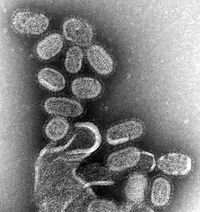
Photo from wikipedia
We developed an organoid culture system derived from the airways of the bat species Carollia perspicillata. Using this cell system, we showed that the airway epithelium of these bats is… Click to show full abstract
We developed an organoid culture system derived from the airways of the bat species Carollia perspicillata. Using this cell system, we showed that the airway epithelium of these bats is highly susceptible to infection by influenza viruses of other mammalian species and thus is not a barrier for interspecies transmission. ABSTRACT Bats are a natural reservoir for many viruses and are considered to play an important role in the interspecies transmission of viruses. To analyze the susceptibility of bat airway cells to infection by viruses of other mammalian species, we developed an airway organoid culture model derived from airways of Carollia perspicillata. Application of specific antibodies for fluorescent staining indicated that the cell composition of organoids resembled those of bat trachea and lungs as determined by immunohistochemistry. Infection studies indicated that Carollia perspicillata bat airway organoids (AOs) from the trachea or the lung are highly susceptible to infection by two different porcine influenza A viruses. The bat AOs were also used to develop an air-liquid interface (ALI) culture system of filter-grown epithelial cells. Infection of these cells showed the same characteristics, including lower virulence and enhanced replication and release of the H1N1/2006 virus compared to infection with H3N2/2007. These observations agreed with the results obtained by infection of porcine ALI cultures with these two virus strains. Interestingly, lectin staining indicated that bat airway cells only contain a small amount of alpha 2,6-linked sialic acid, the preferred receptor determinant for mammalian influenza A viruses. In contrast, large amounts of alpha 2,3-linked sialic acid, the preferred receptor determinant for avian influenza viruses, are present in bat airway epithelial cells. Therefore, bat airway cells may be susceptible not only to mammalian but also to avian influenza viruses. Our culture models, which can be extended to other parts of the airways and to other species, provide a promising tool to analyze virus infectivity and the transmission of viruses both from bats to other species and from other species to bats. IMPORTANCE We developed an organoid culture system derived from the airways of the bat species Carollia perspicillata. Using this cell system, we showed that the airway epithelium of these bats is highly susceptible to infection by influenza viruses of other mammalian species and thus is not a barrier for interspecies transmission. These organoids provide an almost unlimited supply of airway epithelial cells that can be used to generate well-differentiated epithelial cells and perform infection studies. The establishment of the organoid model required only three animals, and can be extended to other epithelia (nose, intestine) as well as to other species (bat and other animal species). Therefore, organoids promise to be a valuable tool for future zoonosis research on the interspecies transmission of viruses (e.g., bat → intermediate host → human).
Journal Title: Microbiology Spectrum
Year Published: 2023
Link to full text (if available)
Share on Social Media: Sign Up to like & get
recommendations!